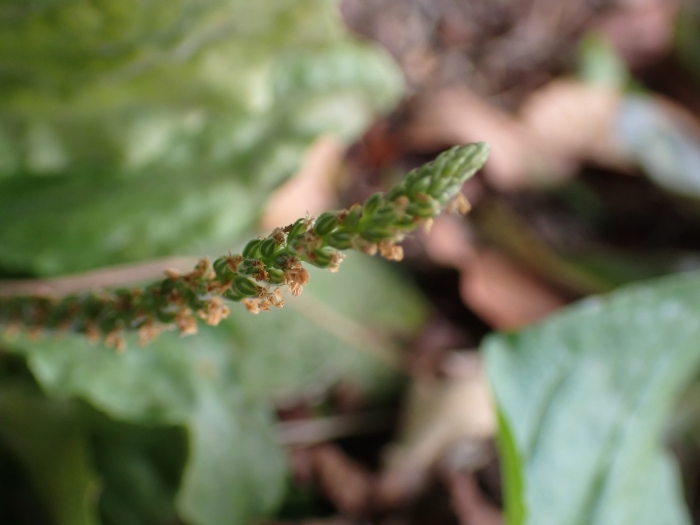Blackseed Plantain
(Plantago rugelii)
Blackseed Plantain (Plantago rugelii)
/
/

Cole Shoemaker
CC BY 4.0
Image By:
Cole Shoemaker
Recorded By:
Copyright:
CC BY 4.0
Copyright Notice:
Photo by: Cole Shoemaker | License Type: CC BY 4.0 | License URL: http://creativecommons.org/licenses/by/4.0/ | Rights Holder: Cole Shoemaker | Publisher: iNaturalist | Date Created: 2021-06-27T11:13:14-07:00 |
























Estimated Native Range
Summary
Plantago rugelii, commonly known as Blackseed Plantain or Rugel’s Plantain, is a perennial herb that is native to a variety of habitats including moist meadows, open woodlands, grasslands, and along stream banks in eastern Canada and the central and eastern United States. It typically forms a basal rosette of wide oval leaves with distinctive red-tinged petioles. The plant reaches a modest height of 6-18 inches (15-45 cm) and produces a flowering scape that bears clusters of small, whitish flowers from late spring to early fall. The flowers are not particularly showy, but they give way to a capsule fruit containing several seeds. Blackseed Plantain is often confused with Plantago major, but can be differentiated by its red petioles and narrower leaves.
Blackseed Plantain is valued for its medicinal properties, as the leaves have been traditionally used for their anti-inflammatory and wound-healing effects. It is also appreciated for its adaptability, as it can thrive in a range of soil types, from moist to moderately dry, and can tolerate partial shade to full sun conditions. While not commonly used for ornamental purposes, it can be a useful ground cover in naturalized areas or in a medicinal herb garden. Gardeners should note that it can become weedy if not managed properly, and it may require control measures to prevent unwanted spread.CC BY-SA 4.0
Blackseed Plantain is valued for its medicinal properties, as the leaves have been traditionally used for their anti-inflammatory and wound-healing effects. It is also appreciated for its adaptability, as it can thrive in a range of soil types, from moist to moderately dry, and can tolerate partial shade to full sun conditions. While not commonly used for ornamental purposes, it can be a useful ground cover in naturalized areas or in a medicinal herb garden. Gardeners should note that it can become weedy if not managed properly, and it may require control measures to prevent unwanted spread.CC BY-SA 4.0
Plant Description
- Plant Type: Herb
- Height: 1-2 feet
- Width: 0.5-1 feet
- Growth Rate: Rapid
- Flower Color: Brown, Green, White
- Flowering Season: Spring, Summer, Fall
- Leaf Retention: Deciduous
Growth Requirements
- Sun: Full Sun, Part Shade
- Water: Medium
- Drainage: Fast, Medium, Slow
Common Uses
Bee Garden, Butterfly Garden, Edible*Disclaimer: Easyscape's listed plant edibility is for informational use. Always verify the safety and proper identification of any plant before consumption., Low Maintenance
Natural Habitat
Native to moist meadows, open woodlands, grasslands, and stream banks
Other Names
Common Names: Rugel’s Plantain, Blackseed Plantain, Pale Plantain, Plantain De Rugel, Tanchagem-Americano, Transagem-Americano
Scientific Names: , Plantago rugelii, Plantago camtschatica, Plantago camtschatica, Plantago kamtschatika, Plantago major, Plantago regelii, Plantago rugelii f. fasciculata, Plantago rugelii var. alterniflora, Plantago rugelii var. asperula,
GBIF Accepted Name: